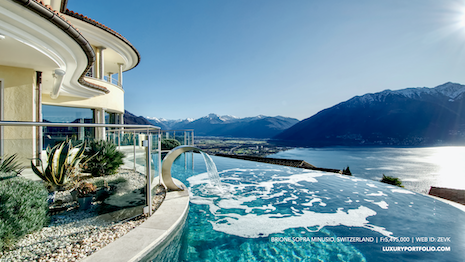 Private amenities such as large swimming pools will continue to be in demand as affluent consumers practice social distancing well into 2021. Image credit: Luxury Society
Private amenities such as large swimming pools will continue to be in demand as affluent consumers practice social distancing well into 2021. Image credit: Luxury Society
A sea change in how affluent consumers are making health-driven lifestyle choices amid the COVID-19 pandemic will continue to shape the luxury real estate market and fuel growth as long as inventory holds out.
Demand for exclusive residential properties will continue well into 2021 even as the vaccine for the coronavirus is widely available to large segments of the United States and global population.
The move to suburbia and a de-urbanization in the U.S., coupled with remote working and schooling, will have lasting effects on the prime real estate landscape for years to come.
Expansive single-family homes in locations that offer more space, freedom and less population density will be highly attractive to high-net-worth and ultra-high-net-worth individuals.
The dominant trend with this affluent segment – swapping their primary residences for second homes or making them co-primary – is here to stay at least for another year or two till the pandemic subsides in the West and other parts of the world.
Here are some of the key trends that will continue into 2021 as the luxury real estate market, along with the stock market, continues its run as one of the brighter spots in the global economy:
Return of the bedroom community
Outlying suburban markets that had seen a great decline due to their lack of proximity to city centers and oversized estates will experience a renaissance as the HNW seek more interior space for working from home and remote schooling and privacy/social distance, as well as larger outdoor spaces for private recreational amenities.
Also, because of remote work flexibility, long commutes into downtown areas will no longer be an issue.
Sight-unseen purchases
Technology such as video conferencing and high-quality property tour videos has allowed many real estate brokers to sell homes of great magnitude to buyers who have never set foot on the property.
This technology has made it easier for real estate agents to sell to foreign buyers, despite lockdown and travel restrictions in many markets.
For many, tire kickers are a thing of the past and brokers are dealing primarily with prospective clients with strong intent to purchase.
Shift in second-home markets
Like bedroom communities, second-home markets will continue to see an influx of clients ready to buy – even in off seasons – because working from home and remote learning has allowed them the flexibility to enjoy perks of resort market life on an ongoing basis, and not just for vacations.
Add to that fervor mind-boggling stock market gains and bargain mortgage rates being locked in by millions across the U.S. market, with the downplaying of financial risks in over-extending household budgets.
Private amenities in high demand
Homes with large yards, pools and outdoor entertaining spaces will not sit on the market for long.
Buyers are looking for all of these amenities in their next home as they gird themselves for the ongoing second wave of COVID-19, with fear of using shared amenities at social clubs – which have been shut down in many cases – and particularly after sheltering in place in smaller urban homes without private access to the outdoors.
In North Carolina, for example, the waiting list to have a pool installed is currently 18-plus months.
Time at home leading to changing preferences
Quarantine, shelter in place or working from home has the HNW rethinking their spaces.
Many consumers have been more inclined to renovate their homes to meet those changing needs – for quality outdoor space, uniquely landscaped gardens, dedicated work or educational spaces and “Zoom Rooms.”
Additionally, real estate brokers are saying that buyers are currently not looking for projects: If they are buying a new home in the current market, they want it move-in ready and suitable to their needs immediately.
MUCH OF THE OUTLOOK for 2021 will remain the same as what has been seen in 2020 until a vaccine is available and consumers are comfortable with, or allowed to, work and travel in a way that resembles the old normal.
That said, some overarching issues will come to a head.
For one, low inventory of prime real estate outside larger cities and towns is currently a big concern and will continue as sellers are too uncertain to list if they do not have a home readily available into which to move.
Next, with lockdowns and travel restrictions, the geographic profile of buyers is changing in many markets across the U.S. and overseas. This also throws into question for locals and foreign buyers the investment potential of grand high-rise luxury developments in cities such as New York, Chicago and London.
Finally, even as resort markets such as the Hamptons outside New York are seeing a surge in demand, urban centers and markets driven by international tourism are suffering.
The fate of vibrant cities such as London and New York is up in the air as the affluent tax base continues its flight, with no office or school to tether them.
All in all, global and U.S. affluent consumers will continue to realign their priorities to spend more on real estate that gives them and their families a sense of security, health safety and privacy in a cocoon all of their own.
For the wealthy, work, school, socializing and entertainment will all have a common home through much of 2021.